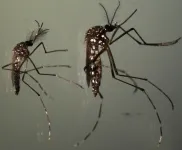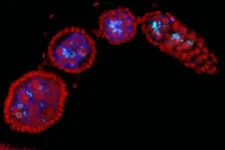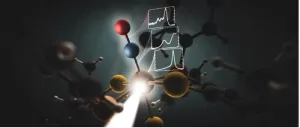(Press-News.org) Philadelphia, October 24, 2023 – Schizophrenia is a severe neuropsychiatric disease that remains poorly understood and treated. Schizophrenia onset is typically in adolescence or early adulthood, but its underlying causes are thought to involve neurodevelopmental abnormalities. Because human prenatal and postnatal brain tissue is exceedingly difficult to procure and therefore study, researchers have had limited opportunities to identify early disease mechanisms, especially during the critical prenatal period. Now, a pair of studies that appear in Biological Psychiatry, published by Elsevier, use new technology to study schizophrenia in models of early human brain development.
The first study used a unique approach involving three-dimensional brain organoids, which are known to recapitulate fetal brain development. The researchers, led by first author Ibrahim A. Akkouh, PhD, and senior author Srdjan Djurovic, PhD, both at Oslo University Hospital, collected skin cells from 14 patients with schizophrenia and 14 healthy controls and generated induced pluripotent stem cells (iPSCs), which they then manipulated to develop into brain-like cortical spheroids.
The organoids grown from patients and controls differed in their expression of thousands of genes – in line with the finding that the genetic influences on schizophrenia are many and very small. However, among the genes, those associated with neuronal axons stood out as a group.
Dr. Akkouh explained, “We identified persistent axonal dysregulation as an early contribution to disease risk.”
Importantly, the researchers assessed organoid maturation at several time points, which enabled them to establish the persistent nature of the disturbances throughout development.
Dr. Akkouh added, “Our findings provide novel and hitherto inaccessible insights into the molecular basis of schizophrenia during early brain development.”
In the second study, researchers led by Roy H. Perlis, PhD, at Harvard Medical School, focused on a particular genetic risk locus. The schizophrenia risk locus 15q11.2, a particular chromosomal region containing four genes, has a penetrance of over 10%, translating to a doubling of risk for schizophrenia among people carrying an unusual copy number of this genetic region. One gene in the locus, CYFIP1, has been associated with synaptic function in neurons and confers increased risk for neurodevelopmental disorders including schizophrenia and autism.
CYFIP1 is highly expressed in microglia, the brain’s own immune cells, but its function there is unknown. Microglia are known to carry out synaptic pruning, in which they “eat” excess synaptic structures, a process critical to healthy brain development.
Dr. Perlis and colleagues collected blood cells from healthy volunteers and isolated iPSCs, which they then manipulated to differentiate into microglia-like cells. The researchers then used CRISPR technology to remove functional CYFIP1 from the cells.
Dr. Perlis said of the work, “Our findings suggest that changes in the behavior and function of microglia due to aberrant CYFIP1 function, such as through coding or copy number variants, could affect microglial processes such as synaptic pruning, homeostatic surveillance, and neuronal maintenance, which are critical for proper brain development and function. This could contribute to CYFIP1-related neurodevelopmental and psychiatric disorders resulting in part from microglia dysfunction. Among the specific disorders linked to variation in CYFIP1 are both autism and schizophrenia.”
John Krystal, MD, Editor of Biological Psychiatry, commented, “The biology of schizophrenia is very complex and yet two themes represented by these two studies seem to be very important: the increased rate of elimination of glutamatergic synapses during development, and disturbances in the signaling properties of these glutamate synapses. These two disturbances could perturb circuit function in ways that are critical to development of symptoms and cognitive impairments associated with schizophrenia.”
Dr. Perlis added, “More broadly, our findings highlight the importance of looking beyond neurons to understand risk genes. While finding risk loci may be the first step in understanding the role of genes in brain diseases, it’s only a first step; figuring out the relevant cell type, and what those genes are doing, is absolutely critical in moving from association to – we hope – actual treatments.”
END
New clues to early development of schizophrenia
Stem cell studies published in Biological Psychiatry open new opportunities for discovery
2023-10-24
ELSE PRESS RELEASES FROM THIS DATE:
What an animated taco reveals about curiosity and patience
2023-10-24
DURHAM, N.C. -- Curiosity paradoxically increases people’s patience for an answer, while simultaneously making them more eager to hear it, finds a new study by Duke neuroscientists.
The research might help teachers and students alike by describing a side of curiosity that encourages us to stay engaged instead of seeking immediate relief.
Die-hard fans of the Hulu show, "The Bear" are left on the edge of their seats each Sunday, wondering what's going to happen in the scrappy Chicago hotdog shop next week. But the new study from Duke helps explain why viewers may choose to avoid spoilers ...
UC Davis, Mars researchers discover scalable production technique for low-calorie sugar substitute
2023-10-24
Scientists at the University of California, Davis, in partnership with the Mars Advanced Research Institute, have announced a significant breakthrough in the production of low-calorie sugar substitutes, such as allulose. This discovery could help address one of the primary obstacles to the widespread adoption of these alternatives: production costs.
Allulose, also known as D-psicose, is a naturally occurring rare sugar that provides a viable alternative to sucrose (table sugar). It has a similar taste, texture and functionality, making it an attractive option for those seeking to reduce their sugar intake. By activating a natural process in a microorganism, researchers have developed ...
Bitcoin mining has “very worrying” impacts on land and water, not only carbon, UN-led study reveals
2023-10-24
American Geophysical Union
24 October 2023
AGU Release No. 23-39
For Immediate Release
This press release and accompanying multimedia are available online at: https://news.agu.org/press-release/bitcoin-mining-has-very-worrying-impacts-on-land-and-water-not-only-carbon/
AGU press contact:
Rebecca Dzombak, news@agu.org (UTC-4 hours)
Contact information for the researchers:
Kaveh Madani, United Nations University, madani@unu.edu (UTC-4 hours)
By the numbers, global bitcoin mining in 2020-2021:
Used 173 terawatt ...
How eggs of the Zika-carrying mosquito survive desiccation
2023-10-24
Eggs of the mosquito that carries Zika virus can tolerate extended desiccation by altering their metabolism, according to a new study publishing October 24th in the open access journal PLOS Biology by Anjana Prasad, Sunil Laxman, and colleagues at the Institute for Stem Cell Science and Regenerative Medicine in Bengaluru, India and the Indian Institute of Technology in Mandi, India. The finding offers potential new ways to control the spread of this mosquito.
Cells are made mostly of water, and desiccation is a potentially fatal event for any organism, since the structures of many proteins and other cellular molecules are dependent ...
How mosquito-controlling bacteria might also enhance insect fertility
2023-10-24
A new study reveals biological mechanisms by which a specific strain of bacteria in the Wolbachia genus might enhance the fertility of the insects it infects—with potentially important implications for mosquito-control strategies. Shelbi Russell of the University of California Santa Cruz, US, and colleagues report these findings in the open access journal PLOS Biology on October 24th.
Different strains of Wolbachia bacteria naturally infect a number of different animals worldwide, such as mosquitos, butterflies, and fruit flies. Wolbachia can manipulate the fertility of their ...
Ancient landscape discovered beneath East Antarctic Ice Sheet
2023-10-24
The research team, led by Durham University, UK, used satellite data and radio-echo sounding techniques to map a 32,000 km2 area of land underneath the vast ice sheet.
They discovered a landscape that appears to have been formed by rivers at least 14 million years ago and possibly even before the initial growth of the East Antarctic ice around 34 million years ago.
This newly discovered landscape consists of ancient valleys and ridges, not dissimilar in size-and-scale to the glacially-modified landscape of North Wales, ...
Cleveland Clinic selected by Wellcome Leap for Two Quantum Computing Research Projects
2023-10-24
Cleveland Clinic has been selected by Wellcome Leap to lead a quantum computing research project, while also playing a significant role in another led by Algorithmiq — both in collaboration with IBM Quantum.
The two contracts were won through Wellcome Leap’s Quantum for Bio Challenge, which will award up to $40 million to 12 researchers globally for research focused on accelerating the development of quantum computing applications for healthcare. Wellcome Leap is a U.S.- based non-profit organization founded by the Wellcome Trust to accelerate and increase ...
SLAC scientists shed light on potential breakthrough biomedical molecule
2023-10-24
Scientists from the Department of Energy’s SLAC National Accelerator Laboratory have gained valuable insights into producing nitroxide, a molecule with potential applications in the biomedical field. While nitric oxide (NO) has long been on researchers' radar for its significant physiological effects, its lesser-known cousin, nitroxide (HNO), has remained largely unexplored.
The study, published recently in the Journal of the American Chemical Society, was born out of a joint endeavor between teams at SLAC’s Linac Coherent Light Source (LCLS) X-ray laser and Stanford ...
Japanese registry finds use of IVUS in coronary interventions reduces mortality and need for coronary bypass surgery
2023-10-24
SAN FRANCISCO – A novel study conducted by a Japanese multicenter registry has revealed the significant benefits of using intravascular ultrasound (IVUS) in coronary intervention procedures. The comprehensive analysis, which focused on enhancing patient outcomes, has provided valuable insights into the effectiveness of IVUS in improving the success rates of these interventions.
The study, titled "Enhancing coronary intervention outcomes with the use of intravascular ultrasound: A comprehensive analysis of long-term benefits in Japanese multicenter registry," sheds light on the positive ...
NIH Kids First program releases nine new data sets for childhood cancer and congenital disorder research
2023-10-24
Philadelphia, PA., October 24, 2023
WHO: The Gabriella Miller Kids First Pediatric Research Program (Kids First), an initiative of the National Institutes of Health (NIH)
WHAT: Kids First announces the release of nine robust new pediatric research datasets spanning childhood cancers, congenital disorders, and cross-condition data. New publicly available datasets include:
PEDIATRIC CROSS-CONDITION
Kids First and INCLUDE: Down Syndrome, Heart Defects, and Acute Lymphoblastic Leukemia
Principal ...
LAST 30 PRESS RELEASES:
Electrodes created using light
Second-hand gift-giving is a well-deliberated decision
How human interaction drove evolution to make bears less aggressive
National Poll: Few parents offer teens guidance on healthy eating during holiday season
Cannabis derivatives could provide new ovarian cancer treatments
Raising strong yeast as a petroleum substitute
Clues to the origin of hot Jupiters hidden in their orbits
Canada’s reduced pledge to Global Fund will impact domestic health
1 in 4 children with major traumatic injuries not cared for in pediatric trauma centres
Duke and Duke-NUS’ joint cross-population research to uncover "East-West" differences in disease and care
Scientists to ‘spy’ on cancer- immune cell interactions using quantum technology breakthrough
Tech savvy users have most digital concerns
Making lighter work of calculating fluid and heat flow
Normalizing blood sugar can halve heart attack risk
Lowering blood sugar cuts heart attack risk in people with prediabetes
Study links genetic variants to risk of blinding eye disease in premature infants
Non-opioid ‘pain sponge’ therapy halts cartilage degeneration and relieves chronic pain
AI can pick up cultural values by mimicking how kids learn
China’s ecological redlines offer fast track to 30 x 30 global conservation goal
Invisible indoor threats: emerging household contaminants and their growing risks to human health
Adding antibody treatment to chemo boosts outcomes for children with rare cancer
Germline pathogenic variants among women without a history of breast cancer
Tanning beds triple melanoma risk, potentially causing broad DNA damage
Unique bond identified as key to viral infection speed
Indoor tanning makes youthful skin much older on a genetic level
Mouse model sheds new light on the causes and potential solutions to human GI problems linked to muscular dystrophy
The Journal of Nuclear Medicine ahead-of-print tip sheet: December 12, 2025
Smarter tools for peering into the microscopic world
Applications open for funding to conduct research in the Kinsey Institute archives
Global measure underestimates the severity of food insecurity
[Press-News.org] New clues to early development of schizophreniaStem cell studies published in Biological Psychiatry open new opportunities for discovery





